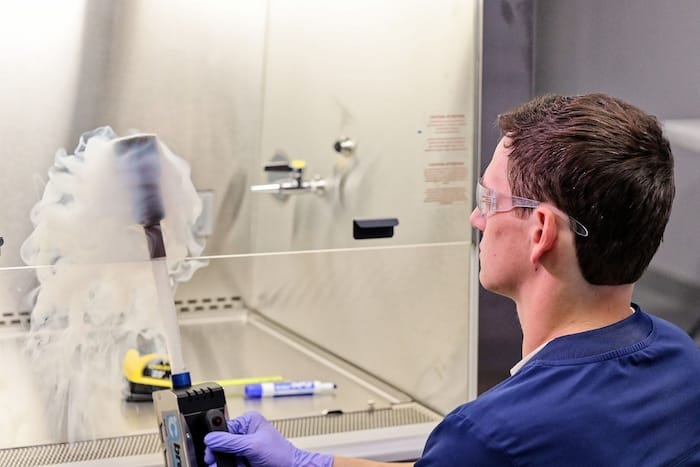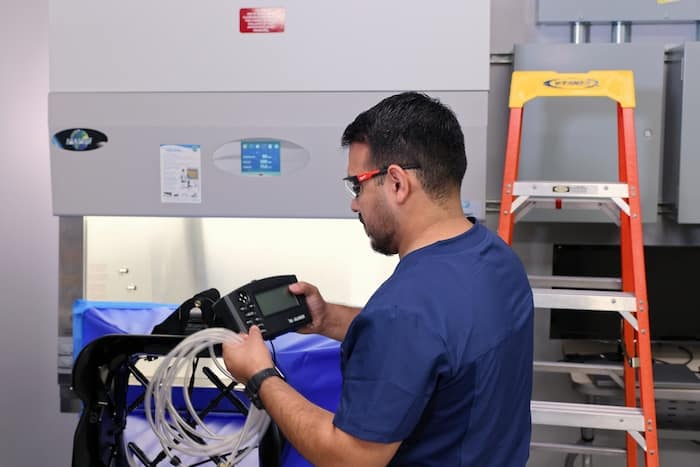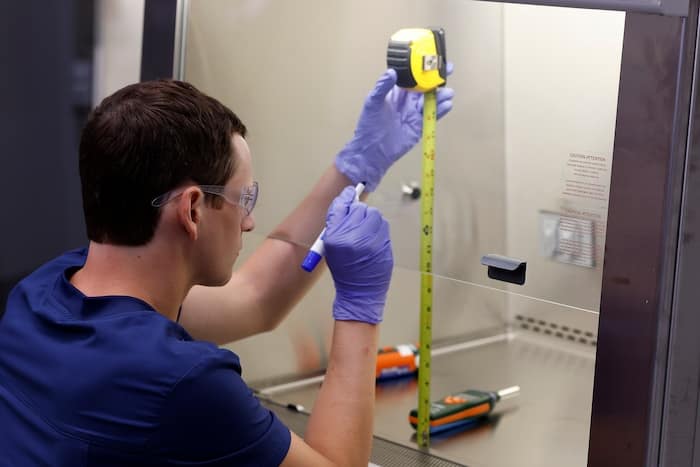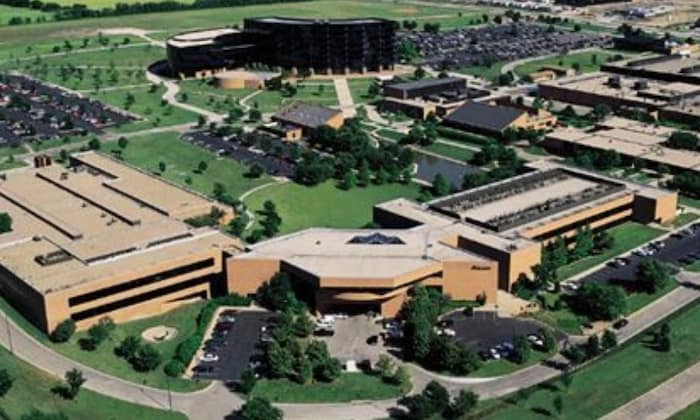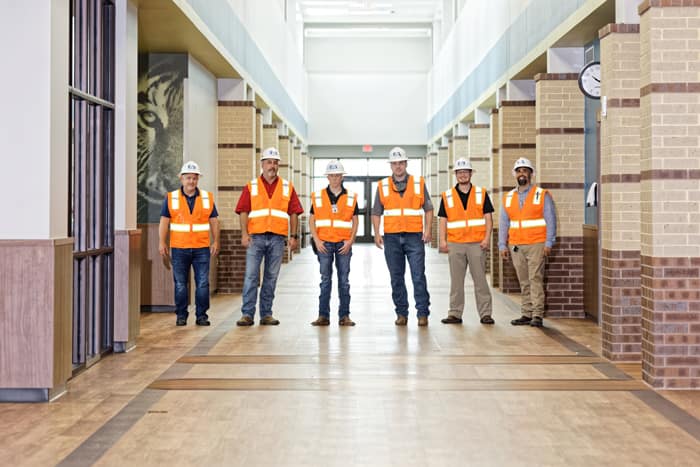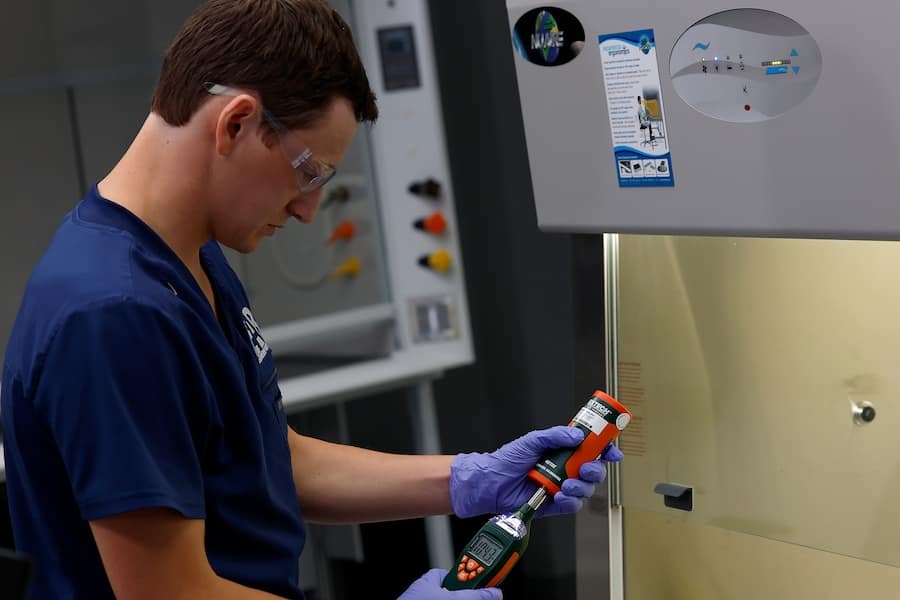
How do facilities in pharmaceuticals, biotechnology, and high-tech manufacturing maintain the ultra-clean environments essential for product integrity and safety? The answer lies in meticulous cleanroom testing. Cleanrooms play a crucial role in controlling airborne particles, ensuring the safety of sensitive products, and protecting both workers and end-users. Without rigorous testing and certification, these controlled environments could fail to meet the stringent standards required for critical operations.
In this article, we’ll explore the essential aspects of cleanroom testing, explain the regulatory frameworks that govern cleanroom performance, and highlight best practices for preparing a cleanroom for certification. To illustrate the real-world impact of expert cleanroom testing, we’ll feature Engineered Air Balance’s (EAB) work with Alcon Laboratories, a success story demonstrating how proper testing safeguards operational excellence.
Why Cleanroom Testing Is Essential
Cleanrooms are specialized environments designed to maintain low levels of airborne particles and contaminants. They are vital in industries such as:
- Pharmaceuticals
- Biotechnology
- Medical device manufacturing
- Semiconductor and electronics production
These environments support processes where even minor contamination can compromise product safety, effectiveness, or reliability. Cleanroom testing verifies that these environments meet strict cleanliness, airflow, and pressure control standards, ensuring product integrity and regulatory compliance.
Key Cleanroom Testing Procedures
1. HEPA Filter Integrity Testing
High-Efficiency Particulate Air (HEPA) filters are the cornerstone of cleanroom contamination control. Their integrity must be verified through rigorous testing:
- PAO Testing: Polyalphaolefin (PAO) or dioctyl phthalate (DOP) aerosols are introduced upstream of the HEPA filter. A photometer measures downstream leakage to confirm filter integrity.
- Photometer Methods: Used to detect any leaks in the filter or housing that could compromise cleanliness.
2. Airborne Particle Counts
Using particle counters, cleanroom testing quantifies the concentration of airborne particles, measured in particles per cubic meter. This data verifies compliance with ISO 14644-1 cleanliness classifications.
3. Airflow Velocity and Volume Measurements
Proper airflow maintains laminar flow and positive pressure, preventing contamination ingress. Testing measures the velocity and volume of air entering and circulating within the cleanroom.
4. Room Air Change Rates
Cleanrooms require frequent air changes to dilute contaminants. Testing determines how many times per hour the cleanroom air is replaced, ensuring compliance with design specifications and regulatory standards.
5. Pressure Differential Testing
Maintaining pressure differentials between cleanroom zones (e.g., between ISO Class 7 and ISO Class 8 areas) prevents contaminated air from flowing into cleaner spaces. Testing verifies that pressure gradients are maintained under normal operating conditions.
6. Recovery Time Assessments
Recovery time testing measures how quickly a cleanroom returns to its specified cleanliness level after a contamination event or personnel entry. This is critical for maintaining operational efficiency and minimizing downtime.
7. Temperature and Humidity Control
Cleanroom environments require precise temperature and humidity control to maintain product stability and prevent static generation or microbial growth. Testing confirms that control systems meet design criteria and remain stable over time.
Best Practices for Cleanroom Preparation and Certification
1. Detailed Documentation
- Maintain accurate as-built drawings, specifications, and change records.
- Document testing procedures, results, and corrective actions.
2. Gowning Protocols
- Implement strict gowning procedures to prevent personnel contamination.
- Provide training and regular audits to ensure compliance.
3. Routine Maintenance
- Perform regular HEPA filter replacements, duct cleaning, and equipment calibration.
- Maintain logs of maintenance activities to support certification efforts.
4. Pre-Testing Inspections
- Inspect all cleanroom components, including doors, seals, and pass-throughs, before testing.
- Verify that systems are fully operational and free from visible contamination.
How Cleanroom Testing Supports Product Integrity and Safety
Cleanroom testing ensures that critical environments:
- Meet design and regulatory standards for cleanliness and performance.
- Prevent contamination that could compromise sensitive products.
- Support regulatory compliance, minimizing the risk of costly delays or product recalls.
- Maintain safe working conditions for personnel handling hazardous materials.
In sectors such as pharmaceuticals and medical devices, a single contamination incident can have serious consequences. Regular testing provides the assurance that cleanrooms consistently deliver the high standards required for product integrity and patient safety.
Success Story: Alcon Laboratories
Alcon Laboratories stands as a testament to the essential role of cleanroom testing in maintaining controlled environments critical to advanced manufacturing. When Alcon expanded its research and production facilities, it faced the challenge of ensuring these clean environments met stringent cleanliness and operational standards.
Through meticulous cleanroom testing, EAB verified the performance of critical systems, including air handlers, filtration systems, and airflow control mechanisms. This testing was essential in maintaining the cleanroom environments that Alcon depends on for research and production.
As a result of EAB’s efforts, the Alcon facility achieved a level of operational excellence, with cleanroom systems functioning efficiently and effectively. This success highlights the critical importance of expert cleanroom testing in ensuring product integrity and maintaining the high standards required in specialized manufacturing environments.
Ensure Cleanroom Excellence with Expert Testing
Cleanroom testing is a vital part of maintaining operational integrity in pharmaceuticals, biotechnology, medical devices, and high-tech manufacturing. Through detailed testing procedures—including HEPA filter integrity, particle counts, airflow verification, and pressure testing—facilities can safeguard sensitive operations and comply with stringent regulatory standards.
The success of Alcon Laboratories demonstrates the impact of expert commissioning and testing on operational excellence and product safety. When you invest in comprehensive cleanroom testing, you’re investing in long-term reliability, compliance, and trust.
If you’re looking to optimize your cleanroom operations, ensure regulatory compliance, and protect product integrity, Engineered Air Balance (EAB) is here to help. Visit EAB’s website today to learn more about our cleanroom testing and commissioning services. Let’s work together to ensure your critical environments meet the highest standards of performance and safety.

